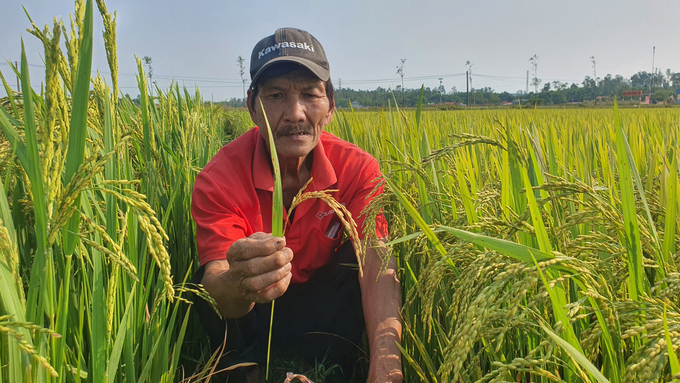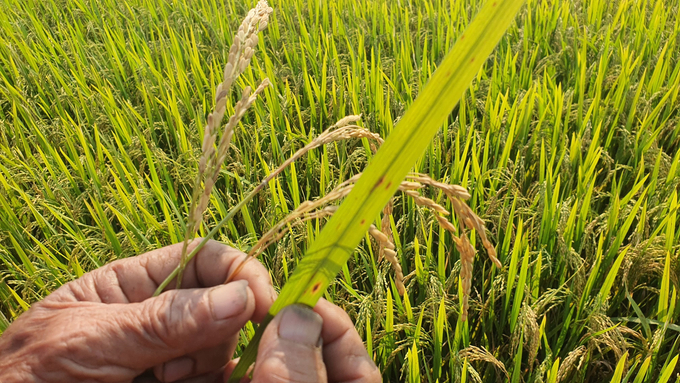In the winter-spring harvest of 2022-2023, the entire Quang Ngai Province sown nearly 38,000 hectares of rice. In which over 6,500 ha of early tea rice are mature and harvested, nearly 28,000 ha of the main crop are in the period of regular flowering – in milk; more than 3,300 ha are in working hours. For official tea and late tea, people have actively tended and monitored the field in the past, as this is the time when the rice plants are very delicate and easily affected by external factors affecting yield, productivity and affect the quality.

Mr. Ho Thanh Xuan’s family (resident in Duc Chanh Township, Mo Duc District, Quang Ngai) had 3 rice sticks with explosive disease. Picture: LK
Like other provinces in the central region, the winter-spring harvest in Quang Ngai is the rice harvest, which farmers have high expectations for. However, the weather in the province has a temperature difference about half a month ago. Warm sunny days, cold nights and early morning hours, combined with fog, created conditions for the occurrence of blast diseases and caused serious damage. So far, this disease has spread to many areas in most of the delta districts of Quang Ngai Province, causing great concern to rice farmers.
Mr. Ho Thanh Xuan (resident in Village 3, Duc Chanh Township, Mo Duc District) said that his family produced 5 sao rice (500 m2) in this year’s winter-spring harvest. Five days ago he visited the fields and discovered that some fields were showing signs of rice blast disease when the rice leaves were densely covered with spots, some areas turned yellow and the rice seeds were dry.
“Currently, about 3 Sao Reis are infected in my house. In the past, many crops, my rice and other people in this area were less prone to blasts, but this year the foggy weather made the fields prone to blast diseases. At this point, I have to buy medicine to prevent spraying, otherwise I’ll definitely have flat seeds, dry cotton, and reduced yield. The effort and money invested in this case is easy to lose,” Xuan said.
When Mr. Nguyen Trung Thanh (residence in Dien Trang Village, Nghia Trung Township, Tu Nghia County) saw that the surrounding paddy fields were infected with rice blast, he was worried every day. Almost every day, Mr. Thanh goes to his paddy field to check and monitor it. Mr. Thanh shared, “Currently it is frosty weather, if fertilizer application is not balanced, surely excess nitrogen will develop and spread widely. Therefore, I have to check regularly to detect and spray preventive drugs in time, but not to treat serious illnesses in time.”

There are black spots on the rice sheets, some of the rice heads have dried. Picture: LK
According to the Subdepartment of Cultivation and Plant Protection of Quang Ngai Province, leaf smut disease is currently widespread in rice tea in the early flowering stage with a total affected area of 750.5 ha. The light infestation is 538 ha, the average infestation is 171.5 ha and the severe infestation is 41 ha. The prevalence is between 5 and 10%, the peak is between 25 and 30% and is in most of the delta districts/cities and the city Quang Ngai spread.
In addition, cotton collard disease also caused local damage to rice tea in the steady flowering stage with a total affected area of 87.2ha. The slightly infected area is 72.7 ha; average infestation 12.5 ha and severe infestation 2 ha. The prevalence of infections ranges from 3 to 8%, in high places from 10 to 20%, distributed in Mo Duc, Tu Nghia, Binh Son, Son Tay and Duc Pho districts Town.
Mr. Nguyen The Vinh, deputy director of Plant Protection and Cultivation Subdivision of Quang Ngai Province, said that through testing in many places, the blast disease has entered the leaf collar, if not actively prevented, the disease will affect the cotton neck, which leads to large losses in yield and quality of the rice.
“Therefore, regarding the cotton neck explosion, the cultivation and crop protection industry recommends the communities and farmers to take the initiative to prevent the rice explosion in paddy fields where the rice disease or paddy fields have occurred. When the rice blooms, the leaves are still green.
People can use any of the medicines to spray this disease, such as: B. Fuji-one 40EC, Filia 525SC, BeamTMPlus 360SC, Map Unique 750WP… and some other drugs indicated except for blast disease. It is recommended to spray twice, the first time when the rice starts to bloom and the second time after the first spraying 5 to 7 days,” Vinh said.

